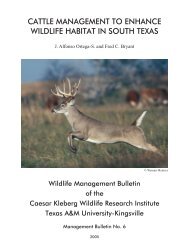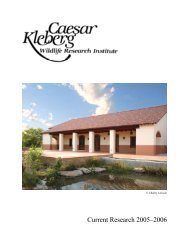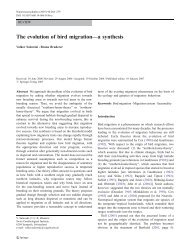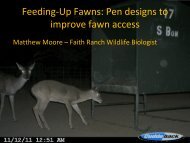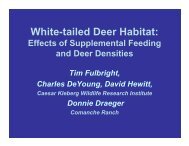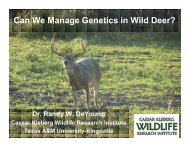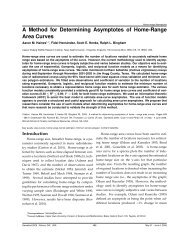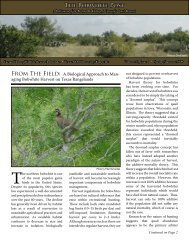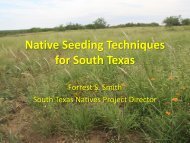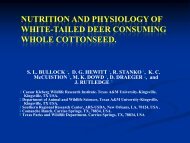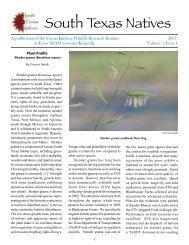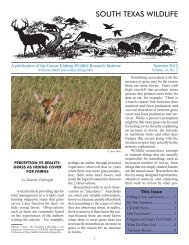The Northern Yellowstone Elk: Density Dependence and Climatic ...
The Northern Yellowstone Elk: Density Dependence and Climatic ...
The Northern Yellowstone Elk: Density Dependence and Climatic ...
You also want an ePaper? Increase the reach of your titles
YUMPU automatically turns print PDFs into web optimized ePapers that Google loves.
<strong>The</strong> <strong>Northern</strong> <strong>Yellowstone</strong> <strong>Elk</strong>: <strong>Density</strong> <strong>Dependence</strong> <strong>and</strong> <strong>Climatic</strong> ConditionsAuthor(s): Mark L. Taper <strong>and</strong> Peter J. P. GoganSource: <strong>The</strong> Journal of Wildlife Management, Vol. 66, No. 1 (Jan., 2002), pp. 106-122Published by: Allen PressStable URL: http://www.jstor.org/stable/3802877Accessed: 01/11/2009 17:58Your use of the JSTOR archive indicates your acceptance of JSTOR's Terms <strong>and</strong> Conditions of Use, available athttp://www.jstor.org/page/info/about/policies/terms.jsp. JSTOR's Terms <strong>and</strong> Conditions of Use provides, in part, that unlessyou have obtained prior permission, you may not download an entire issue of a journal or multiple copies of articles, <strong>and</strong> youmay use content in the JSTOR archive only for your personal, non-commercial use.Please contact the publisher regarding any further use of this work. Publisher contact information may be obtained athttp://www.jstor.org/action/showPublisher?publisherCode=acg.Each copy of any part of a JSTOR transmission must contain the same copyright notice that appears on the screen or printedpage of such transmission.JSTOR is a not-for-profit service that helps scholars, researchers, <strong>and</strong> students discover, use, <strong>and</strong> build upon a wide range ofcontent in a trusted digital archive. We use information technology <strong>and</strong> tools to increase productivity <strong>and</strong> facilitate new formsof scholarship. For more information about JSTOR, please contact support@jstor.org.Allen Press is collaborating with JSTOR to digitize, preserve <strong>and</strong> extend access to <strong>The</strong> Journal of WildlifeManagement.http://www.jstor.org
THE NORTHERN YELLOWSTONELK: DENSITY DEPENDENCEAND CLIMATICONDITIONSMARK L. TAPER,1 Department of Ecology, Montana State University, Bozeman, MT 59717, USAPETER J. P. GOGAN, U.S. Geological Survey, <strong>Northern</strong> Rocky Mountain Science Center, Department of Ecology, Montana StateUniversity, Bozeman, MT 59717, USAAbstract: We analyzed a time series of estimates of elk (Cervus elaphus) numbers on the northern <strong>Yellowstone</strong> winterrange from 1964 to 1979 <strong>and</strong> 1986 to 1995 using a variety of discrete time stochastic population dynamic models.<strong>The</strong>se models included adjustments for density, an increase in the area of winter range used by elk, lagged effectsof the weather covariates of spring precipitation, snow depth <strong>and</strong> winter temperature, <strong>and</strong> the impacts of the 1988drought <strong>and</strong> fires. An information-criteria-based model-selection process strongly supported evidence of densitydependence. <strong>The</strong> best model, a Ricker model, distinguished between the 2 time periods. <strong>The</strong> bulk of the differencebetween the 2 periods is attributed to an increase in the amount of winter range used by elk. Inclusion of thecovariates spring precipitation <strong>and</strong> spring precipitation squared greatly improved the model fit. We detected ashort-lived increase in elk population growth rate following the 1988 drought <strong>and</strong> fires. Fertility <strong>and</strong> survivorshipof adults appeared to have different density-dependent forms that together result in a biphasic relationshipbetween population growth rate <strong>and</strong> density. This study confirms the presence of density-dependent regulation inthe northern <strong>Yellowstone</strong> elk herd, <strong>and</strong> enhances our underst<strong>and</strong>ing of population dynamics of these ungulates.JOURNAL OF WILDLIFE MANAGEMENT 66(1):106-122Key words: Cervus elaphus, density dependence, elk, Greater <strong>Yellowstone</strong> Area, information criteria, Montana, nonlinearpopulation dynamics, population dynamics, Wyoming.<strong>Yellowstone</strong> National Park (YNP) supports 8 elkherds that intermingle on the summer ranges(Mack <strong>and</strong> Singer 1993) within YNP but are identifiedby use of distinct wintering areas within <strong>and</strong>beyond the borders of YNP. With minimum populationestimates exceeding 17,000 during winters1992-1993, 1993-1994, <strong>and</strong> 1994-1995 (Lemke etal. 1998), the northern <strong>Yellowstone</strong> elk herd is thelargest of the 8 herds. <strong>The</strong> herd is supported by ex-tensive areas of grassl<strong>and</strong> <strong>and</strong> shrub steppes within<strong>and</strong> beyond the borders of YNP (Houston 1982).Many researchers have noted changes in the lifehistory parameters of the northern <strong>Yellowstone</strong>elk herd that are consistent with a density-dependentresponse (Houston 1982, Merrill <strong>and</strong> Boyce1991, Cheville et al. 1998, Singer et al. 1998). However,such changes are considered insufficient proofof density dependence (McCullough 1990). Truedensity-dependent population regulation has beenindicated by regressions of growth rate on populationsize (Houston 1982, Merrill <strong>and</strong> Boyce 1991,Dennis <strong>and</strong> Taper 1994). Nonetheless, contentionstill exists on the extent to which the herd exhibitsdensity dependence because in recent years populationsizes have increased beyond the ecologicalcarrying capacity predicted by Houston (1982). Followingrelease from artificial controls within the1 E-mail: taper@rapid.msu.montana.edupark, the herd size increased to 14,000-15,000during the 1970s through mid-1980s (Merrill <strong>and</strong>Boyce 1991), 17,800 during 1985-1988 (Merrill<strong>and</strong> Boyce 1991), <strong>and</strong> >19,000 during 1993-1994(Lemke et al. 1998). However, rigorous reevaluationof the data analyzed by Houston (1982) confirmshis calculations (Dennis <strong>and</strong> Taper 1994).An interplay of dynamic natural ecologicalprocesses <strong>and</strong> human management activitiesthroughout the range of the northern <strong>Yellowstone</strong>elk herd have continued to impact theherd's population dynamics. For example, expansionof the extent of the winter range by con-tinued pioneering of herd segments northwardfrom the park boundary <strong>and</strong> extensive use ofthese more northerly areas by greater numbers ofelk have been coincident with acquisition <strong>and</strong>conversion of rangel<strong>and</strong>s from livestock productionto elk winter range (Lemke et al. 1998).Also, the adult sex ratio shifted from one highlyskewed by intense culling activities within YNP ofapproximately 50 males:100 females during the1960s to approximately 25 males:100 females bythe late 1980s (Mack <strong>and</strong> Singer 1993). <strong>The</strong> im-pact of the 1988 wildl<strong>and</strong> fires on northern rangeelk numbers have been predicted to be relativelyshort-lived (Turner et al. 1994) or cause a declineof 5-10% during the first 5 years but increasednumbers 15-25 years post-fire (Coughenour <strong>and</strong>Singer 1996). Similarly, the reintroduction of106
J. Wildl. Manage. 66(1):2002DENSITY DEPENDENCE IN YELLOWSTONELK * Taper <strong>and</strong> Gogan 107wolves (Canis lupus) to YNP has the potential of more, National Park Service, unpublished report).dramatically affecting the size <strong>and</strong> population Censuses from fixed-wing aircraft began duringparameters of the northern <strong>Yellowstone</strong> elk herd winter 1967-1968 <strong>and</strong> continued to 1994-1995.(Garton et al. 1990, Boyce <strong>and</strong> Gaillard 1992, Boyce <strong>The</strong> elk herd was counted several times annually1993, Mack <strong>and</strong> Singer 1993, Messier et al. 1995). from a single fixed-wing PA-18 Supercub fromWe investigated the northern <strong>Yellowstone</strong> elk 1968 to 1979 (Houston 1982), with the highestpopulation data from the inception of aerial counts obtained between mid-December <strong>and</strong> midcountsduring 1965 through 1995 to underst<strong>and</strong> January. Annual counts since 1986 have been conthenature of the population dynamics. Rigorous ducted with 4 Supercubs, each covering a segmentevaluation of density dependence in the north- of the northern range (Lemke et al. 1998), ideallyern <strong>Yellowstone</strong> elk herd is important for scientif- on a single morning. However, in some instances,ic interest but also for evaluating the appropriate- flying conditions <strong>and</strong> logistical constraints haveness of human management actions. We explored forced the census to be staggered over several daysthe effects of range expansion, wildfires, <strong>and</strong> cli- (Lemke et al. 1998). <strong>The</strong> counts are made duringmate on population changes. We addressed the early winter when elk occupy non-forested porquestionsof whether or not the northern Yellow- tions of the northern range <strong>and</strong> are more readilystone elk herd exhibited density dependence <strong>and</strong> detected against a snow-covered l<strong>and</strong>scape. Fromassessed the shape of density-dependent functions 1968 to 1975, we combine information from W. J.influencing the population. Such an assessment Barmore (National Park Service, unpublished re-provides a backdrop for underst<strong>and</strong>ing the im- port), Houston (1982), <strong>and</strong> Lemke et al. (1998) aspacts of natural processes <strong>and</strong> human activities, our source of data for 1976 to 1995 (Table 1).such as hunting <strong>and</strong> restoration of wolves on thenorthern <strong>Yellowstone</strong> elk herd.Age <strong>and</strong> Sex CompositionHerd ageSTUDY AREA<strong>and</strong> sex composition were determinedeach January from 1968 through 1979<strong>Elk</strong> of the northern <strong>Yellowstone</strong> winter range from ground surveys adjusted for under-repreoccupyan area of 1,410 km2 of foothills <strong>and</strong> valley sentation of adult males by the percent adultbottoms along the Lamar, <strong>Yellowstone</strong>, <strong>and</strong> Gar- males sighted during aerial surveys (Houstondiner rivers, with approximately 1,000 km2 within 1982). During winter 1985-1986 through winterthe boundaries of YNP <strong>and</strong> 500 km2 on the Gal- 1989-1990, herd composition was assessed from alatin National Forest <strong>and</strong> privately owned l<strong>and</strong>s helicopter covering one-third of the northernnorth of the YNP boundary in Montana (Houston range (Singer et al. 1997) during early winter1982, Coughenour <strong>and</strong> Singer 1996, Lemke et al. (an) <strong>and</strong> late winter (mid-Feb through mid-Apr).1998). Elevations range from 1,500 to 2,500 m. During winter 1990-1991, the early winter com-Mean annual precipitation ranged from 35 cm in position was determined from a similar helitheupper Lamar River valley to 24 cm on the Yel- copter count, but the late count was conductedlowstone River at the YNP boundary (Coughenour from the ground. Thus, the proportion of males<strong>and</strong> Singer 1996). Vegetation of the area is pri- in this late count is an underestimate (Houstonmarily grassl<strong>and</strong> or sagebrush steppe (Houston 1982). Early <strong>and</strong> late winter herd composition1982). Dominant plant species of grassl<strong>and</strong> <strong>and</strong> estimates were made during winter 1991-1992 folsteppeare Idaho fescue (Festuca idahoensis), blue- lowing the sampling regime used by Singer et al.bunch wheatgrass (Pseudoroegneria spicata), <strong>and</strong> big (1997). No composition counts were conductedsagebrush (Artemisia tridentata; Houston 1982, during winters 1992-1993 or 1993-1994. Only lateTurner et al. 1994). Coniferous forest of Douglas- winter (Mar) composition estimates were madefir (Pseudotsuga menziesii) <strong>and</strong> lodgepole pine from a helicopter during winters 1994-1995 <strong>and</strong>(Pinus contorta) occurs at higher elevations at the 1995-1996. In some instances, we found discrepperipheryof, <strong>and</strong> as isolated st<strong>and</strong>s within, the ancies between early winter composition estimatesgrassl<strong>and</strong> <strong>and</strong> sagebrush steppe (Houston 1982). determined from the original data sheets on fileat YNP <strong>and</strong> those reported by Coughenour <strong>and</strong>METHODSSinger (1996:582). We present the YNP file datacorrections used in our analyses (Table 2).Census Data<strong>The</strong> elk herd was censused from helicopter dur- Data Selection <strong>and</strong> Adjustmenting winters 1964-1965 <strong>and</strong> 1966-1967 (W. J. Bar- Several counts (1976-1977, 1988-1989, <strong>and</strong>
108 DENSITY DEPENDENCE IN YELLOWSTONE ELK * Taper <strong>and</strong> GoganJ. Wildl. Manage. 66(1):2002Table 1. Count <strong>and</strong> removal adjusted population estimates, northern <strong>Yellowstone</strong> <strong>Elk</strong> herd, winters 1964-1965, Montana <strong>and</strong>Wyoming, USA. (Except where otherwise noted, data are from W. J. Barmore, National Park Service, unpublished report; Houston1982; Lemke et al. 1998; <strong>and</strong> Montana Department of Fish, Wildlife <strong>and</strong> Parks unpublished annual hunt reports 1985-1995.)Post-hunt Next fall pre-hunt Total Post-count Pre-countWinter period Count estimate estimate removals removals removals1964-19651965-19661966-19671967-19681968-19691969-19701970-19711971-19721972-19731973-19741974-19751975-19761976-19771977-19781978-19791979-19801980-19811981-19821982-19831983-19841984-19851985-19861986-19871987-19881988-19891989-19901990-199119921993199419954,4763,8423,1724,3055,5437,2818,2159,98110,52912,60712,01412,68010,83816,01916,28617,00718,91316,536e14,82912,027e12,85917,58519,04516,7914,8655,2273,8423,1724,3095,5437,2828,2159,98110,52912,60710,82510,741 b11,87810,80715,11415,38716,162d18,73718,94514,50611,33011,07216,01118,83214,7526,4976,5344,2724,3555,5937,3268,29010,13510,73912,75412,35410,96012,94111,14916,47316,88517,90119,31617,02315,80512,33515,58718,06619,35917,2901,9041,2702,6921,100505045751542101471,5292191,063342661376C1,3591,8812,0611,5711,4981,7395792,8961,2991,0054,5152,0555272,538a Includes other winter mortality of 44 (W. J. Barmore, National Park Service, unpublished report).b Houston (1982:23) adjustment.c Corrects typographical error in Lemke et al. (1998).d Addition error corrected from Lemke et al. (1998).e Sightability corrected numbers.00000000001,1890802319058998451762,4093236971,7871,5742132,0391,9041,2702,692a1,100505045751542101473402192613114545998944034879763082,7284813144991990-1991) are marked in the original records asunreliable due to poor census conditions (Lemkeet al. 1998). Growth rates estimated from year-toyeartransitions that include any of these years arenot included in the primary analyses regardingthe strength of density dependence. Furthercomplications occur when we consider the 1988drought <strong>and</strong> associated wildfires. <strong>The</strong>se wildfiresmay have affected elk demographics. Becausethey are a single event, it is difficult to investigatetheir impact statistically. Also, the 1992-1993transition in elk numbers appears deviant. <strong>The</strong>observed growth rate of 0.49 is a large outlier forthe dataset. Furthermore, this growth rate isslightly greater than the physiologically maximumpossible growth rate (0.46) given the interpolatedsex ratio for this year. Consequently, weremoved the 1992-1993 transition from the primaryanalyses. Last, 1988-1989 through 1991-1992are considered post-fire years <strong>and</strong> analyzed separatelyfrom the main body of data. Coughenour<strong>and</strong> Singer (1996) present "corrected" estimates
J. Wildl. Manage. 66(1):2002DENSITY DEPENDENCE IN YELLOWSTONE ELK * Taper <strong>and</strong> Gogan 109Table 2. Late winter age <strong>and</strong> sex composition of the northern<strong>Yellowstone</strong>lk herd, winters 1987-1988 through 1995-1996,Montana <strong>and</strong> Wyoming. Data are from records archived at <strong>Yellowstone</strong>National Park, Mammoth, Wyoming, USA.Calves: Yearling M: Adult M:Year 100 F 100 F 100 F n1987-1988 23 4 15 5,1031988-1989 6 2 13 2,8271989-1990 19 3 12 3,3931990-1991 26 - - 1,9251991-1992 44 - - 3,5301994-1995 33 11 29 3,6131995-1996 28 9 26 2,902of elk numbers for winters 1986-1987 through1990-1991 by adjusting numbers to account forthe proportion of radiocollared elk that were notseen during the st<strong>and</strong>ard aerial censuses.Coughenour <strong>and</strong> Singer's (1996) calculationsindicate that even in good survey years, aerialcensuses post-1986-1987 underestimate the populationlevels on the order of 25%. However, forthe 1988-1989 <strong>and</strong> 1990-1991 censusesCoughenour <strong>and</strong> Singer (1996) believe that only49 <strong>and</strong> 51% of the population was counted,respectively, confirming the census participants'assessments. We reduced the Coughenour <strong>and</strong>Singer (1996:574) corrected estimates for1988-1989 <strong>and</strong> 1990-1991 by 25% to make themcomparable with the rest of the count data.Early <strong>and</strong> Late Periods<strong>The</strong> census data do not form a continuousrecord. No population estimates were made during1980, 1981, 1983, or 1984. Consequently,growth rates are not available from 1979 to 1984.This divides the time series into an early (i.e.,1964-1979) <strong>and</strong> a late (i.e., 1986-1995) period.Adjusting for HuntingBecause our intent was to investigate the naturalregulation of the northern <strong>Yellowstone</strong> elkherd, we corrected for hunting to discern theunderlying natural population dynamics regardlessof whether hunting is density-dependent ordensity-independent. <strong>The</strong> annual elk cycle in <strong>Yellowstone</strong>begins with calving in spring, resultingin a population increase (Fig. 1). Perinatal mortalityreduces the population size somewhat(Singer et al. 1997), <strong>and</strong> then the populationenters a period with comparatively low naturalmortality until late winter (Green et al. 1997).Superimposed on this cycle are annual total herdcounts at the beginning of each year <strong>and</strong> annualhunting mortality. This population is subjectedto a regular-season hunt <strong>and</strong> a late-season hunt.<strong>The</strong> regular hunt has occurred between lateOctober <strong>and</strong> late November since the mid-1960s(Erickson 1981). <strong>The</strong> late hunts have varied fromlate November through early March during themid-1960s, mid-December through mid-Februaryduring the early 1980s, <strong>and</strong> earlyJanuary to mid-February during the 1990s (Erickson 1981,Lemke et al. 1998). Thus, the count <strong>and</strong> mosthunt mortality occur during a period of low naturalmortality. This allows us to study densitydependence in this herd as it would haveoccurred in the absence of hunting. We calculatea pre-hunt population estimate by adding all legalharvest plus known illegal kills <strong>and</strong> lost woundedanimals presumed to have died that occurredbefore the annual count to the estimated herdsize (Lemke et al. 1998). In a similar fashion, apost-hunt population estimate is constructed bysubtracting known subsequent anthropogenicmortality from the census (Table 1). We investigatednatural population regulation by studyingthe statistical dependence of transitions in populationnumbers from post-hunt to pre-hunt thenext year on post-hunt population size.Correcting for Range Expansion<strong>Density</strong> dependence by definition relatesgrowth rates to population densities. Calcula-tions based on raw population counts will not bevalid if range expansions or contractions occur.<strong>The</strong> winter range for the northern <strong>Yellowstone</strong>elk herd increased during the early 1980sPre-huntestimatez Z I /_ \6iPerinatal mortalityAerialcount Post-huntestimateCalving Early Latehunt huntWinter mortalityMay Jul Sep Nov Jan Mar MayJun Aug Oct Dec Feb AprFig. 1. Schematic diagram of annual cycle of elk numbers, timingof natural <strong>and</strong> human-induced mortality <strong>and</strong> sampling,northern <strong>Yellowstone</strong>lk herd, Montana <strong>and</strong> Wyoming.
110 DENSITY DEPENDENCE IN YELLOWSTONE ELK * Taper <strong>and</strong> GoganJ. Wildl. Manage. 66(1):2002(Coughenour <strong>and</strong> Singer 1996, Lemke et al.1998). <strong>The</strong>se authors estimated that between1980 <strong>and</strong> 1985 (between our early <strong>and</strong> late periods),the extent of the winter range increased41%. In analyses that relate to population densities,we adjust the estimated population numbersduring the late period by dividing by 1.41. Thisexpresses all estimates as densities in units of animalsper pre-1980 winter range.Testing for <strong>Density</strong> <strong>Dependence</strong>To legitimately test for density dependence intime series of population estimates, one musthave a true a priori hypothesis that is null <strong>and</strong>alternative models that are specified beforeinspecting the data. Following Dennis <strong>and</strong> Taper(1994), we used a null model of exponentialgrowth <strong>and</strong> an alternative model of Ricker density-dependentgrowth. We used a parametric bootstraplikelihood ratio (PBLR) test (Dennis <strong>and</strong>Taper 1994). This procedure regresses populationgrowth rate as a response variable against apredictor variable of population size. <strong>The</strong> distinctionbetween the PBLR test <strong>and</strong> a st<strong>and</strong>ard regressionis that the PBLR develops the distribution ofthe test statistic under the null hypothesis by simulation.Thus, it gives a true size to the test of densitydependence. <strong>The</strong> test also is robust againstmeasurement error (Dennis <strong>and</strong> Taper 1994).Identifying the Form of PopulationDynamicsIdentifying Population Dynamic Process withSchwarz's Information Criterion.-Because legitimatehypothesis testing requires a single pair ofnull <strong>and</strong> alternative hypotheses, it often is quiteconstraining. Model mis-specification is a majorsource of error in data analysis (Chatfield 1995,Buckl<strong>and</strong> et al. 1997, Burnham <strong>and</strong> Anderson1998). Model identification is an approach thatminimizes the risk of model mis-specification bycomparing the goodness-of-fit of a whole suite ofmodels. A number of possible criteria for comparingmodels exist. We prefer the informationcriteria methods because of their strong statisticalfoundations (Sakamoto et al. 1986, Burnham<strong>and</strong> Anderson 1998) <strong>and</strong> because the validity ofits application to the identification of populationdynamic models in time-series analysis has beeninvestigated through simulation (Hooten 1995).Although model identification formally selectsa single model from a suite of models, as opposedto testing a single null against a single alternative,the process can still be used to compare classes ofmodels. All the population dynamic models weinvestigated were classified as density-independentor density-dependent models. Thus, if themodel identified as the best model is a memberof the set of density-independent models, thenthe population dynamics are considered to bedensity-independent, while, if the identifiedmodel is a member of the density-dependent set,the population dynamics are classified as densitydependent(Hooten 1995, Zeng 1996, Zeng et al.1998). Because of the multiple models involved<strong>and</strong> because explicit P-values are not calculated,such a classification by model identification doesnot per se constitute a hypothesis test. Nonetheless,if the compared models have been includedon an a priori basis, then the comparison retainsmuch of the epistemological st<strong>and</strong>ing of ahypothesis test (Burnham <strong>and</strong> Anderson 1998).<strong>The</strong>re are a variety of possible information criteriato choose from (Hooten 1995). All informationcriteria are constructed as -2*(log-likelihood)+ (an adjustment). <strong>The</strong> adjustment is afunction of the number of parameters or of thenumber of parameters <strong>and</strong> the number of observations.<strong>The</strong> adjustment for Akaike's InformationCriterion (AIC; Akaike 1973) is 2*p (p = the numberof parameters including the error variance),while the adjustment for Schwarz's InformationCriterion (SIC; Schwarz 1978) contains a samplesize correction so that the adjustment is the numberof parameters times the natural logarithm ofthe number of observations. <strong>The</strong> model with thelowest value for the information criterion used isselected as the best-supported model. However,this selection should not be considered absolute.If the difference in information criteria (IC) valueof 2 models is slight, then it is best to consider themodels more or less equally supported <strong>and</strong> retainboth for consideration. Differences in informationcriterion values (AIC) of >2 are generallyconsidered to indicate that models are statisticallydistinguishable (Sakamoto et al. 1986).It has been shown both theoretically (Stone1979) <strong>and</strong> through simulation (Hooten 1995)that the SIC estimates the true order of theunderlying model more accurately than the AIC.Furthermore, the SIC tends to choose models oflower order than the AIC (when the selection differs).In contrasting between density-independent<strong>and</strong> density-dependent classes of models,this feature will make the identification of densi-ty dependence conservative as the density-dependentmodels contain more parameters than thedensity-independent models (Zeng et al. 1998).
J. Wildl. Manage. 66(1):2002DENSITY DEPENDENCE IN YELLOWSTONE ELK * Taper <strong>and</strong> Gogan 111(AIC)Ricker, 2 a, & lb,v (0.00)Ricker, 1 a, b, & v (0.43)Ricker, 2 b, & 1 a,v (0.75)Ricker, 2 a, b, & 1 v (0.80)Gompertz, 2 a, b, & 1 v (2.00)Gompertz, 2 b, & 1 a,v (2.75)Gompertz, 1 a, b, & v (3.36)Ricker, 2 a, b, & v (3.48)Gompertz, 2 a, b, & v (4.59)Exp single model (5.74)Gompertz, 2 a, & 1b,v (6.60)Exp double model (11.16)R<strong>and</strong>om walk (18.68)Two stationary dist (41.21)Single stationary dist (59.70)-25 -20 -15 -10 -5 -0SIC valuesFig. 2. Schwarz Information Criteria (SIC) selection for appropriatemodels to describe observed trends in populationchange, northern <strong>Yellowstone</strong>lk herd, 1965-1995, Montana<strong>and</strong> Wyoming. Values of SIC for each model are given inparentheses on the Y-axis. Numbers of intercept (a), slope(b), <strong>and</strong> error (v) terms indicated.On the other h<strong>and</strong>, selection by minimum AIC isasymptotically equivalent to selection by minimumprediction error (Stone 1977). Becauseour primary intention is to identify the underlyingform of population dynamics of the northern<strong>Yellowstone</strong> elk herd <strong>and</strong> not to make explicitpredictions, use of the SIC is appropriate.Models Considered.-<strong>Density</strong>-independent modelclasses are r<strong>and</strong>om walk <strong>and</strong> exponential growthmodels. Included in the density-dependent classare Gompertz (1825) <strong>and</strong> Ricker (1954) models.We included models that differentiated populationdynamics in the early <strong>and</strong> late periods fordensity-independent <strong>and</strong> density-dependentgrowth model classes. For example, we consideredRicker <strong>and</strong> Gompertz growth models withintercept, slope, <strong>and</strong> variance parameters commonto the early <strong>and</strong> late periods, <strong>and</strong> Ricker <strong>and</strong>Gompertz models that allowed >1 of these parametersto differ between the periods. In Rickermodels, the relationship between growth rate<strong>and</strong> population density is linear, while for Gomnpertzmodels, growth rate is linearly associatedwith the logarithm of population size (Fig. 2).We also included the stationary statistical distri-bution models. This class of models does notassume any dependence of population size at agiven time on the population size at any previoustimes. Population sizes are simply assumed to bedrawn from some r<strong>and</strong>om distribution.Surprisingly, in such a situation, growth rateswill be negatively correlated with population size.This phenomenon was first pointed out by Eberhardt(1970), <strong>and</strong> has been discussed recently byWolda <strong>and</strong> Dennis (1993) <strong>and</strong> by Wolda et al.(1994). Wolda <strong>and</strong> Dennis (1993) demonstratethat rainfall can yield a significant result in a testof density dependence. This may be disturbing tobiologists. However, stationary statistical distributiondoes not necessarily indicate an absence ofdirect causal density dependence. For example, aGompertz growth model with a growth rate parameterof 1 will generate a log-normal stationarydistribution of population sizes where populationsize at a given time is independent from populationsize at any previous time. We have explicitlyincluded the stationary statistical distributionmodel class to alleviate the uncertainty generatedby this situation. If a model is identified as a density-dependentmodel but is strongly distinguishablefrom a stationary distribution, then a caveatthat could be raised against deciding the populationdynamics represents biological densitydependence has been removed.Recent work has successfully used nonparametriccurve fitting <strong>and</strong> generalized additive modelsto investigate density dependence in natural populations(Bj0rnstad et al. 1999). <strong>The</strong>se techniquesare data intensive; for example, Bj0rnstadet al. (1999) analyzed a composite dataset with250 observations. Such an approach cannot besuccessfully applied to the northern <strong>Yellowstone</strong>elk herd because of the paucity of data.Assessing the Impacts of EnvironmentalFactorsTo determine the impact of weather on thepopulation dynamics of the northern <strong>Yellowstone</strong>elk herd, we include weather variables as covariatesin some population dynamic models. Fames'(1996) weather severity index is a weighted sumof 3 normalized components: winter forage avail-ability, snow depth, <strong>and</strong> winter temperature. Allcomponents are constructed so that higher num-bers indicate milder winters. Thus, a high valuefor the snow component indicates low snow levels.We do not use Fames' full index, but insteaduse his 3 components directly. This enables themost effective weightings to emerge from thedata. Weather variables used (Table 3) comefrom Fames' most recent revision of his compilationof 30 of <strong>Yellowstone</strong> climate data (P. Fames,Soil Conservation Service, personal communica-tion). We consider these 3 variables, their l-yearlags (previous year's values), <strong>and</strong> all squares ofthese variables in looking for the effect of weatheron elk population dynamics. We also considerthe current spring's precipitation <strong>and</strong> its square.
112 DENSITY DEPENDENCE IN YELLOWSTONE ELK * Taper <strong>and</strong> GoganJ. Wildl. Manage. 66(1):2002Table 3. Winter condition indices for the lower northern <strong>Yellowstone</strong>winter range, Wyoming (after Fames [1996] <strong>and</strong> P.Fames, Soil Conservation Service, 1998 [personal communication]).Season19641965196619671968196919701971197219731974197519761977197819791980198119821983198419851986198719881989199019911992199319941995Temperatureindex0.7-2.62.42.91.22.12.41.41.3-2.82.4-0.9-0.72.91.8-4-0.63.60.32.9-3.4-3.50.9-0.40.1-2.91-2.41.6-0.81.60.7Snowindex-0.1-3.23.2-3.8-1.9-1.1-1.6-3.3-3.23-3.6-2.8-3.83.3-2.7-1.61.33.8-1.70.82.10.723.53.1-1.6-1.11.621.72.1-0.8Forageindex-0.62.52.5-2.432.41.91.4-3.21.9-2.7-3.30.91.7-0.7-3.5-2.9-0.42.51.323.2-1.22.53.3-3.7-2.2-2.8-3.943.7-0.4Winter forage was not directly measured, butFames assumed the previous spring's precipitationcan act as a surrogate. Coughenour <strong>and</strong>Singer (1996) demonstrated a correlation betweenthe previous spring's precipitation <strong>and</strong>winter forage. Thus, previous spring's precipitationshould affect overwinter survival, while currentspring's precipitation might be expected toinfluence perinatal mortality. Weather variableswere included as covariates (Rothery et al. 1997,Dennis <strong>and</strong> Otten 2000) in Ricker <strong>and</strong> Gompertzdensity-dependent models <strong>and</strong> in exponentialgrowth density-independent models. SchwartzInformation Criterion values were comparedamong regressions of all possible subsets of predictorvariables (Neter et al. 1996). To avoidselection bias (Zucchini 2000, Taper 2002), nomodel was considered that had >8 variablesincluding error variance, intercept, populationdensity, <strong>and</strong> weather variables. Thus, there werealways >2x as many data points (year-to-year transitionsin herd numbers) as variables estimated.Delayed <strong>Density</strong> <strong>Dependence</strong>Delayed density dependence has beenobserved in red deer (Cervus elaphus; Forchhammeret al. 1998). To investigate the impact ofdelayed density dependence in the northern Yel-lowstone elk herd, we perform a model identificationanalysis on a reduced dataset of all transitionsfor which the previous year's density alsohas been observed (3 consecutive yearly popula-tion estimates). This reduces the number ofobservations from 17 to 13 transitions. All possiblesubsets regression was performed as abovebut with the inclusion of the previous year's populationdensity as a possible predictor variable<strong>and</strong> the current year's density.Assessing the Impacts of 1988 Drought<strong>and</strong> FiresWe compare population estimates for the postfireyears (1989-1996) with predictions based onthe pre-1988 data to discern the impact of the1988 drought <strong>and</strong> wildfires on the northern <strong>Yellowstone</strong>elk herd's population dynamics. We inspectedthe magnitude <strong>and</strong> direction of residualsof observations from predictions for evidence ofdrought <strong>and</strong> fire influence.Post hoc Analyses<strong>The</strong> analyses described above are true a priorianalyses decided on before inspection of the data.<strong>The</strong> following analyses were inspired by featuresin the data we became aware of during detailedinvestigation. Epistemologically, these analyseshave the st<strong>and</strong>ing of exploratory data analyses.<strong>The</strong> Interaction of <strong>Density</strong> <strong>and</strong> Life History Traits.-Because growth rate is a synthetic parameter aris-ing from more fundamental demographic rates,an observed dependence of growth rate on populationsize implies there must be density dependencein some combination of underlying demographictraits. We investigated fertility <strong>and</strong>survival rate directly for indications of densitydependence. <strong>Density</strong>-dependent immigration<strong>and</strong> emigration have been indicated to be importantin the dynamics of some species (Stacey <strong>and</strong>
J. Wildl. Manage. 66(1):2002DENSITY DEPENDENCE IN YELLOWSTONE ELK * Taper <strong>and</strong> Gogan 113Taper 1992, Stacey et al. 1997). Unfortunately,data are not available for us to verify the existenceof permanent long range movements inthis population or to determine the densitydependentnature of the process. However, lowdispersal rates for the northern <strong>Yellowstone</strong> elkherd have been documented (Houston 1982).Fertility.-Fertility often is defined as the numberof female offspring produced/female thatsurvive to the first population census or estimatefollowing birth (Keyfitz 1985, Caswell 2001).However, because the herd composition surveysdo not identify calf sex, we define fertility as thenumber of calves produced/female that surviveto the first census. Fertility is calculated as theratio of the estimated number of calves in thepopulation at the time of the next winter's compositionsurvey divided by the number of femalesestimated in the post-hunt population of the previouswinter. <strong>The</strong> composition surveys do not dis-tinguish yearling females from reproductivelymature females. Our demographic model incor-porates these data to minimize the consequencesof this constraint.Survival Rate. We define adult survival rate asthe ratio of the estimated number of adults in thepre-hunt estimate for the following year to theestimated number of adults in the post-hunt estimate.We are unable to separately estimate thesurvival of males <strong>and</strong> females; the hunt data donot completely break the kill down into males<strong>and</strong> females. Because this estimate of survivaldoes not follow marked cohorts but depends onraw population estimates, survival rate estimates>1 can <strong>and</strong> do occur.Curve Fitting.-<strong>The</strong> estimates for fertility <strong>and</strong>survival rate are plotted against population den-sity. Based on these plots, we decided on appropriatefunctional forms for recruitment <strong>and</strong> survivalrate <strong>and</strong> estimated the parameters of thesemodels using nonlinear curve fitting. We usedMarquardt's (1963) algorithm to fit the curves.Composition counts are sporadic during thelate period. As a consequence, there are only afew years during the late period where recruitment<strong>and</strong> survival rates were estimated. We baseour estimates of survival <strong>and</strong> fertility/densitydependence curves solely on data from the earlyperiod.A Simple Demographic ModelTo incorporate the nonlinearity in the northern<strong>Yellowstone</strong> elk herd population dynamics thatour initial analysis discovered, we constructed asimple demographic model of population growth.Population growth rate (rt) is modeled as:rt= n ( (N) fNt + s (Nt)Nt)Nt(1)where Nt is population size, m(Nt) is fertility, ft isproportion of females in the population at time t,<strong>and</strong> s(Nt) is survivorship.This simple formulation allows for separatedensity dependence in survivorship (s[Nt]) <strong>and</strong>in fertility (m[Nt]). <strong>The</strong> major drawback of thisapproach is that the model does not distinguishbetween yearling females <strong>and</strong> reproductivelymature females. On average, this is incorporatedin the estimate of fertility. However, some of theyear-to-year variation in observed growth rate maybe due to variation in the proportion of the populationof females in the pre-reproductive stage.We used appropriate parametric forms for survivorship(s[Nt]) <strong>and</strong> fertility (m[Nt]) derivedfrom inspection of the estimated rates. Marquardt'salgorithm had convergence problems sowe fit equation 1 with the Nelder/Mead downhillsimplex method, a very robust technique for nonlinearregression (Nelder <strong>and</strong> Mead 1965, Presset al. 1992). We also investigated nonlinearity inthe elk population dynamics, using a 0-Rickermodel (Gilpin <strong>and</strong> Ayala 1973, Thomas et al.1980, Hooten 1995)Interpolation of the Proportion of Females. <strong>The</strong>proportion of adult females in the population isa necessary parameter for predicting growth rateusing the demographic model. This informationis missing for 1992-1993 <strong>and</strong> 1993-1994. However,there is noticeable continuity in the proportion offemales in the population through time. <strong>The</strong>refore,we constructed estimates of the proportionof adult females in the population for those 2 yearsfrom surrounding data using linear interpolation.RESULTSTesting for <strong>Density</strong> <strong>Dependence</strong><strong>The</strong> 17 transitions that comprise the time seriesare divided into 4 unbroken sub-series (Table 1).<strong>The</strong> parametric bootstrap of the Dennis <strong>and</strong>Taper (1994) test was conditioned on the initialpopulation sizes for each sub-series. Despite thetime series' brevity <strong>and</strong> its division into multiplesub-series, both of which should reduce thepower of a test, a 1-sided test was significant atapproximately P = 0.009 (2-sided test P= 0.018).This justifies rejecting the a priori null hypothe-
114 DENSITY DEPENDENCE IN YELLOWSTONE ELK * Taper <strong>and</strong> GoganJ. Wildl. Manage. 66(1):2002L.cICll0n ..a I I0.50.0-0.52,0 )00 7,000 12,000 17,000 22Minimum winter count1. .w0.50.0A BIX,) ( i IIIII1 II I I I In .. --U,02,000i Ii i iI IIIII()!~ ~ !(3~IIIIII1 1IIII7,000 12,000 17,000 22Minimum winter densityFig. 3. Estimated carrying capacities, marked by verticaldashed lines for the northern Yellowston elk herd, Montana<strong>and</strong> Wyoming, based upon counts (a, upper panel) <strong>and</strong> correctedfor increase in size of the winter range (b, lower panel).Note that the X-axis is total count in the upper panel <strong>and</strong> densityin the lower panel. Circles indicate observations from theearly period, while squares indicate the late period.sis of growth rate independent of population <strong>and</strong>accepting the alternative hypothesis that growthrate declines with population density.Identifying the Form of Population Dynamics<strong>The</strong> best density-independent model found wasexponential growth with the same parameters inthe early <strong>and</strong> the late periods (Fig. 2). <strong>The</strong> bestdensity-dependent model in the set explored wasa Ricker model with separate intrinsic growthrates (a) in the 2 periods, but single coefficient ofdensity-dependent decline (b) <strong>and</strong> single processerror for both periods. <strong>The</strong> difference in theinformation criteria (AIC) between these modelsis 5.74. Differences of >2 generally are consideredsignificant (Sakamoto et al. 1986), while differencesof >5 are deemed extremely significantby Burnham <strong>and</strong> Anderson (1998). Thus, modelidentification using SIC supports the presence ofdensity dependence in the population dynamicsof the northern <strong>Yellowstone</strong> elk herd. A differenceof 2.0 between the best SIC values for Rick-er models over Gompertz models provides somesupport for Ricker-like density dependence overGompertz-like density dependence. <strong>The</strong> verylarge differences between the stationary distribu-tion models <strong>and</strong> our best models indicate thatthe observed density dependence is biological,<strong>and</strong> not a statistical artifact. <strong>The</strong> poor performanceof the stationary distribution models canbe attributed to the long stretch of continuousgrowth in the early period.<strong>The</strong> best model (Fig. 2) distinguishes betweenthe early <strong>and</strong> late periods in that some parametersare fit separately for the periods. However,there is so little difference (AIC = 0.34) betweenthis model <strong>and</strong> a Ricker model fit over the entiredataset that the models are not statistically distinguishable.With only 5 usable transitions in thelate period, our ability to characterize the populationdynamics of this period is weak. If countsin the late period are not adjusted to densities toaccount for the increase in area of winter rangeoccupied in the late period, the results are differentwith the best 2-period model (Ricker) beingsuperior (AIC = 4.2) to the best single-periodmodel (Gompertz). Thus, the bulk of the apparentdifferences between the periods can be attributedto the increase in the amount of winterrange used by the northern <strong>Yellowstone</strong> elk herd.In a comparison of the best model for the unadjusteddata (Fig. 3a) with the best model for therange expansion adjusted data (Fig. 3b), approx-imately 60% of the population increase isaccounted for by range expansion. <strong>The</strong> remainingincrease in population size is due to an increasein density at the estimated equilibrium.However, exactly quantifying how much of theincrease in elk abundance is due to range expansionis complicated by the uncertainty in modelselection. Considering the 4 statistically indistin-guishable best models (Fig. 2), 2 models indicatethat range expansion accounts for almost all ofthe observed population increase (Figs. 4b,d)while 2 models indicate that increases in densityare involved (Figs. 4a,c). <strong>Density</strong> dependence isa component of all of these models, but the portionof population increase accounted for byrange expansion varies from 60 to 100%. Regressionequations for all parametric a priori modelsare given in Table 4.<strong>The</strong> Impact of Weather on <strong>Elk</strong> DynamicsBecause density has a large effect on elk populationdynamics, it is included in the set of potentialvariables with weather variables. <strong>The</strong> SIC best
J. Wildl. Manage. 66(1):2002DENSITY DEPENDENCE IN YELLOWSTONE ELK * Taper <strong>and</strong> Gogan 1150I-In , , I Iq I, , ,0.5AIC = 0 aIto , ^^ ^II I-II0mAIC = 0.43 1 bI-0.5I _0)LI0.0Annre2,000---''--_-i i i i8,000 14,000Minimum winter densityII20,0000_Ih.I0.0_n._lCp [X InII2,000 8,000 14,000Minimum winter density004.'I-00)h.I8,000 14,000Minimum winter density20,0008,000 14,000Minimum winter densityFig. 4. Display of best 4 a priori models to describe observed trends in population change, northern <strong>Yellowstone</strong> elk herd,1965-1995, Montana <strong>and</strong> Wyoming. Note that the difference between early <strong>and</strong> late estimates of population equilibrium varieswidely among these statistically indistinguishable models.model out of all possible models of order
116 DENSITY DEPENDENCE IN YELLOWSTONE ELK * Taper <strong>and</strong> GoganJ. Wildl. Manage. 66(1):2002Table 4. Regression equations for a priori models to describe observed trends in population change, northern Yellowston elkherd, 1965-1995, Montana <strong>and</strong> Wyoming. N is population size, X is In(N), <strong>and</strong> Z is Gaussian r<strong>and</strong>om variable with mean 0 <strong>and</strong>variance 1. IE <strong>and</strong> IL are indicator functions for the early <strong>and</strong> late periods, respectively. Arguments to the indicator functions areonly expressed for observations from that period.Model nameRegression equationRicker, 2a, & lb,v IE(0.375) + IL(0.483) - (3.009 x 10-5)N + 0.084ZRicker, 1a, b, & v 0.330 - (2.124 x 10-5)N + 0.093ZRicker, 2b, & 1 a,v 0.373 + IE([-2.942 x 10-5] N) + 0.086ZRicker, 2a, b, & lv IE(0.357 - [2.76 x 10-5] N) + IL(1.017 - [7.477 x 10-5] N) + 0.079ZGompertz, 2a, b, & 1vIE(1.790 - 0.186 x 10-5]X) + IL(8.900 - 0.902 x 10-5] X) + 0.082ZGompertz, 2b, & la,v 1.550 + IE(-0.158X) + IL(-0.147X) + 0.102ZGompertz, la, b, & v 1.118 - 0.107X + 0.101ZRicker, 2a, b, &v IE(0.357 - [2.762 x 10-5] + 0.082Z) + IL(1.017 - [7.477 x 10-5] + 0.071Z)Gompertz, 2a, b, &vIE(1.790 - 0.188X + 0.086Z) + IL(8.90 - 0.902X + 0.071Z)Exp single model 0.146 + 0.118ZGompertz, 2a, & lb,vIE(3.051) + IL(3.323) - 0.329X + 0.102ZExp double modelIE(0.155 + 0.119 Z) + IL(0.124 + 0.111Z)R<strong>and</strong>om walk 0.187Z(1989-1992) with predicted growth rates forthose years based on our best model of density<strong>and</strong> environmental effects (Fig. 6). In the first 2years following the fire, the observed growthrates are below predicted values, while in thethird <strong>and</strong> fourth seasons, growth rates are considerablyabove the predicted values. <strong>The</strong> residualsfor the last 2 years of the time series seemlarger than the pre-fire portion of the time series.It appears that the major effects of the 1988 firesp p2N (0.00) IT p p2N (0.92)p s2p2N (1.06)ps2F2p2N (1.26)Sp p2N (1.44)TSpp2N (1.95)t p p2N (1.98)(AIC) , I , II I I I 1-27.0 -26.5 -26.0 -25.5 -25.0 -24.5SIC values__Fig. 5. Schwarz Information Criteria (SIC) selection for appropriatemodels to describe the impacts of density <strong>and</strong> weatheron population growth rate, northern <strong>Yellowstone</strong> elk herd,1965-1995, Montana <strong>and</strong> Wyoming. Values of SIC for eachmodel are given on the Y-axis. Symbols: t, s, <strong>and</strong> f are temperature,snow, <strong>and</strong> forage for the current winter; T, S, <strong>and</strong> Fare temperature, snow <strong>and</strong> forage for the previous winter; p isprecipitation for the current spring.on elk population dynamics were brief. It shouldbe noted that although the observed 1989 growthrate is below the predicted growth rate, the residualis quite small. Caution should be taken ininterpreting these post-fire residuals because theanalysis depends heavily on sightability correctionsthat have very large uncertainties.<strong>Density</strong> <strong>Dependence</strong> in Component LifehistoryTraitsWe examined the estimated demographic ratesversus density for the early period. Fertility (Fig. 7)was fitted using a log-linear model. Adult sur-vivorship (Fig. 8) is fit with a nonlinear regressionmodel, S(N) = exp(a - bN). <strong>The</strong> parameter a wasconstrained not to exceed 0 so that survivorshipcannot appear to exceed 1 as population sizegoes to 0. Data points from the late period areincluded in the fit. Our decision to eliminate thelate period from the fit for fertility while includ-aL 0.40 a.(D0.6-0.20.0-0n!+ +? la A+~00!9+ e9 + +A+t-* +M. I . I . I . I . Il . I . .65 70 75 80Year85 90 95Fig. 6. Patterns of observed (circles, squares), predicted(crosses) <strong>and</strong> immediate post-fire observed (triangles) growthrates, northern <strong>Yellowstone</strong> elk herd, 1965-1995, Montana<strong>and</strong> Wyoming. Single Ricker model with density, spring precipitation<strong>and</strong> spring precipitation squared as covariates.
J. Wildl. Manage. 66(1):2002DENSITY DEPENDENCE IN YELLOWSTONELK * Taper <strong>and</strong> Gogan 1170.71.1-0.600Early period1.0-.SEarly period._0.4-0.3 '.0* 4zr.20.S00.200.803,000 4,000 5,000 6,000 7,000 8,000 9,000 10,000 11,000 12,000 13,000Post-hunt density0.7t I3,000 4,000 5,000 6,000 7,000 8,000 9,000 10,000 11,000 12,000 13,000tFig. 7. Changes in estimated fertility with population density,northern <strong>Yellowstone</strong> elk herd, 1965-1980, Montana <strong>and</strong>Wyoming. E(F) = exp(-0.108 - 0.00102*Nt).Post-hunt densityFig. 8. Changes in estimated adult survivorship with populationdensity, northern <strong>Yellowstone</strong>lk herd, 1965-1980, Montana<strong>and</strong> Wyoming. E(S) = exp(-0.219*N3 77).ing the late period in the fit for survivorship isbased on inspection of the data <strong>and</strong> the observationthat the only environmental effects indicatedto be important by model identification usingthe linear regression were current spring precipitation<strong>and</strong> current spring precipitation squared.<strong>The</strong>se variables are expected to influence fertilitybut not adult survivorship. Calculation of survivorshipfrom population counts does not allowdistinguishing mortality from emigration.Inserting the above submodels for fertility <strong>and</strong>survivorship into the simple demographic modelof equation 1 produces a model with an SIC ofonly -12.8. Alternatively, one can fit the parametersof this model directly to the population transitiondata using the Nelder/Mead downhill-simplexalgorithm. <strong>The</strong> fit is similar, although notquite as good (SIC = -11.4). Clearly, the demographicmodel is not supported over the simpleRicker model of population dynamics. Nonetheless,density dependence in both fertility <strong>and</strong>adult survivorship is strongly suggested (Figs. 7,8). We believe the demographic model is notsupported because it requires 2 extra parameters;this is a heavy penalty to pay with so few datapoints, <strong>and</strong> the demographic model requires theuse of the herd composition assessments. Thisintroduces new measurement errors <strong>and</strong> biasesto the analysis <strong>and</strong> probably degrades the performanceof the model.One of the consequences of density dependencein fertility <strong>and</strong> adult survivorship (Figs. 7,8) is a biphasic relationship between populationgrowth rate <strong>and</strong> density (Fig. 9). At low density,population growth rate is dominated by densitydependence in fertility, while high density populationgrowth rate is dominated by density dependencein adult survivorship (Fig. 9). This demonstratesthe biphasic nature to growth rateimposed by separate density dependence in fer-tility <strong>and</strong> survivorship. Curvature in the relationshipbetween growth rate <strong>and</strong> density can bemodeled in a simple fashion using a 0-Rickermodel (Gilpin <strong>and</strong> Ayala 1973, Thomas et al.1980, Hooten 1995). <strong>The</strong> SIC for this model is-22.58 with AIC = 1.99, indicating this model isnot clearly distinguishable from our best model.Thus, density dependence may be nonlinear inthe northern <strong>Yellowstone</strong> elk herd.00.4-0.3-0.2? 0.10.0-0.1%5,~ ^ Early period'., I* Observed r ,- - - Predicted r " *- Predicted r with average sex ratio *\I I I j3,000 4,000 5,000 6,000 7,000 8,000 9,000 10,000 11,000 12,000 13,000Post-hunt densityFig. 9. Biphasic density dependence in the northern <strong>Yellowstone</strong>elk herd, 1965-1980, Montana <strong>and</strong> Wyoming. <strong>The</strong>dashed line plots the growth rate predicted by the demographicmodel (Equation 1) using the observed sex ratio foreach year. <strong>The</strong> solid line plots the growth rate derived fromthe model assuming that the sex ratio is constant throughout.
118 DENSITY DEPENDENCE IN YELLOWSTONE ELK * Taper <strong>and</strong> GoganJ. Wildl. Manage. 66(1):2002DISCUSSION<strong>Density</strong> dependence in the population growthrate of the northern <strong>Yellowstone</strong> elk herd isstrongly supported by several aspects of ouranalysis. First, a true a priori test (Dennis <strong>and</strong>Taper 1994) rejects the null hypothesis of densityindependence. This is more significant than thetest of density dependence for this populationreported in Dennis <strong>and</strong> Taper (1994). Two differencesbetween the current analysis <strong>and</strong> that ofDennis <strong>and</strong> Taper (1994) account for this change.First, we include the late period in our analysis,while Dennis <strong>and</strong> Taper (1994) worked just withthe early period. Second, we adjust for huntingmortality while Dennis <strong>and</strong> Taper (1994) did not.Perhaps, more appropriately, model identificationalso strongly supports density dependence inthe elk herd. In comparing the best density-independentmodel to the best density-dependentmodel, we find a AIC of 5.74. This indicates densitydependence is more than 300x more stronglysupported by the data than is the absence ofdensity dependence.Currently, the <strong>Yellowstone</strong> northern elk populationis capable of regulating itself. <strong>The</strong> populationequilibrium numbers in the absence of hunting(based on minimum counts) seem to besomewhere between 20,000 <strong>and</strong> 25,000 elk for thesize <strong>and</strong> quality of the current winter range.Undoubtedly, this underestimates the equilibriumpopulation size somewhat because of sightabilityissues.Our analysis indicates that although estimatesof the area of expansion are crude, the bulk ofthe population increase can be attributed to theexpansion of winter range to the north of YNP.Range expansion directly reduces density by increasingthe denominator in the ratio of populationsize to area occupied. Further, range expansionmay have a negative density-dependenteffect as the energetic dem<strong>and</strong>s of longer migrationsincrease at greater population sizes(Messier et al. 1988).Environmental changes have been involved to alesser extent in the increase in ecological carryingcapacity in the late period. Spring precipitationof the current year <strong>and</strong> spring precipitationsquared were identified as contributing effects.Calf:female ratios have been correlated positivelywith winter <strong>and</strong> summer precipitation 2 years earlier<strong>and</strong> negatively correlated with the previousyear's spring precipitation for 1970-1971 through1990-1991 (although the latter relationship wasonly marginally significant; Coughenour <strong>and</strong>Singer 1996). Other variables are included inmodels not statistically distinguishable from themodel including only current spring precipitation<strong>and</strong> density (Fig. 5). Further, the weathervariables are correlated, <strong>and</strong> thus, the identificationof predictive variables is not stable (Neter etal. 1996). A more secure statement is that environmentalfactors do contribute to elk populationdynamics.Singer et al. (1997) reported that Fames'(1996) winter severity index for the current yearwas not correlated with over-winter survival of elkcalves for winters 1968-1969 through 1991-1992.However, between 1987-1988 <strong>and</strong> 1990-1991,summer survival of radiocollared elk calves wasnot correlated with current year precipitation<strong>and</strong> over-winter survival of these calves was correlatedwith Fames' (1996) winter severity index forthe current winter. This may indicate an interactionbetween the effects of density <strong>and</strong> environmentalvariation in which winter severity has amore profound impact on calf (<strong>and</strong> adult) survivalunder conditions of high density. This patternhas been reported in other ungulate populations(Clutton-Brock et al. 1987, Choquenot1991). Winter carcass surveys during the lateperiod (Green et al. 1994) show a strong (adjustedR2 = 0.73) <strong>and</strong> significant (P= 0.02) regressionof elk carcasses on Fames' winter severity index(C. Schwartz, U.S. Geological Survey, personalcommunication).Our comparison of predicted <strong>and</strong> observedgrowth rates following the 1988 fire corroboratesthe simulation findings of Turner et al. (1994)that predicted a mild, but short-lived, increase inelk growth rate due to fire. Boyce <strong>and</strong> Merrill(1996) also modeled a post-fire peak <strong>and</strong> declinein the population size of the northern <strong>Yellowstone</strong>elk herd. However, the timing of the peak<strong>and</strong> the rate of return to background levels weobserve are much more rapid than thoseassumed by Boyce <strong>and</strong> Merrill (1996). Thus, inagreement with empirical work (Pearson et al.1995, Boyce <strong>and</strong> Merrill 1996, Vales <strong>and</strong> Peek1996) <strong>and</strong> the simulations of Turner et al. (1994)<strong>and</strong> Wu et al. (1996), we found that the 1988 firewas not responsible for the large decline in theherd from 1989 to 1990. <strong>The</strong> high 1988 populationsize <strong>and</strong> severe spring drought accounted forvirtually the entire decline. We also support theconclusions of these researchers that there was ashort-lived enhancement to elk habitat after thefire. This boost seems to have been in effect duringthe 1991-1992 <strong>and</strong> 1992-1993 years.
J. Wildl. Manage. 66(1):2002DENSITY DEPENDENCE IN YELLOWSTONELK * Taper <strong>and</strong> Gogan 119During recent years, there has been a growing iarityinterest in underst<strong>and</strong>ing the potential of nonlinearityin density-dependent population dynamics(Fowler 1994, Clutton-Brock et al. 1997, Higginset al. 1997, Ellner et al. 1998, McCullough 1999).An important aspect of this study is that fertility<strong>and</strong> adult survivorship have distinct nonlinearrelationships with density. When these 2 relationshipsare coupled through a simple demographicmodel, a biphasic or ramped density dependencecurve emerged. Ramps in growth rate/densitycurves have been considered by other authors(Fowler 1980, 1981; McCullough 1990, 1992,1999). In these papers, the ramp was generatedby a physiological maximum to reproductive rate.Thus, our observation that different demographicrates can have distinct density-dependent rela-tionships, which can combine to yield rampeffects, is a previously unidentified mechanismfor generating nonlinearity in growth rates.<strong>The</strong>se datasets are unusual in following growth ofa population from very low levels to near carryingcapacity. Most studies are restricted to a muchnarrower range of population sizes making it difficultto detect ramp effects or density dependencein adult survival (Gaillard et al. 1998). Yetpredictions of expected time to recovery of adepleted population or expected time to extinctionmay be biased by neglecting these changesin the slope of density dependence function (Pascualet al. 1997).Eberhardt (1977) suggested that density-dependentresponses in life history should follow theorder: (1) juvenile survival, (2) age of first reproduction,(3) adult reproductive rate, <strong>and</strong> finally(4) adult survival. We are not able, given thedata, to distinguish life-history stages 1 through 3.<strong>The</strong>y all contributed to the fertility we estimate.However, the onset of density dependence inadult survival is at a much higher population levelthan for fertility (Figs. 7, 8). An interesting fea-ture of the density dependence of fertility is it isconcave (Fig. 7). This contrasts with observationson a number of other ungulate species reviewedby Fowler (1994). A further contrast between thisstudy <strong>and</strong> reviews of ungulate dynamics is thepresence of density dependence in adult survival.Gaillard et al. (1998) indicated that densitydependence in adult survival seems rare.Our analysis is unable to distinguish betweenmortality <strong>and</strong> emigration. Thus, it is possible thatthe declines in adult survivorship observed athigh densities are the result of adults permanentlyleaving the herd. Experts with long famil-with the herd do not believe this is the case(D. B. Houston, U.S. Geological Survey, personalcommunication). Smith <strong>and</strong> Anderson's recentstudy (2001) of dispersal in the nearby Jacksonelk herd (Gr<strong>and</strong> Teton National Park) indicatesthat mature adult elk are extremely herd faithful.<strong>The</strong> little dispersal that did occur was by juveniles,<strong>and</strong> did not appear in their study to have adensity-dependent component. Further, mortalityof dispersers from the Jackson herd was muchgreater than that of nondispersers.MANAGEMENT IMPLICATIONSManagement of the northern <strong>Yellowstone</strong> elkherd has been controversial throughout the 20thcentury. Between 1935 <strong>and</strong> 1968, annual reductions(by trapping <strong>and</strong> shooting) inside <strong>and</strong> outsideYNP removed 1,500animals from the northern <strong>Yellowstone</strong> elk herdby sport hunters (Lemke et al. 1998).<strong>The</strong> increase in the size of the northern <strong>Yellowstone</strong>elk herd has been concomitant with amajor expansion of the herd's winter rangebeyond the YNP boundaries (Lemke et al. 1998).At present, a variable portion of the herd movesduring each fall <strong>and</strong> winters north of YNP onother public (chiefly USDA Forest Service) <strong>and</strong>private l<strong>and</strong>s where management authorityresides with the Montana Department of Fish,Wildlife <strong>and</strong> Parks (MDFWP; Lemke et al. 1998).This expansion has been in part facilitated <strong>and</strong> sup-
120 DENSITY DEPENDENCE IN YELLOWSTONE ELK * Taper <strong>and</strong> GoganJ. Wildl. Manage. 66(1):2002ported by establishment of the Dome MountainWildlife Management Area by MDFWP <strong>and</strong> acquisitionof other private l<strong>and</strong>s north ofYNP by sporthuntingorganizations. <strong>The</strong> MDFWP is responsiblefor establishing harvest quotas during aregular fall hunt <strong>and</strong> a late winter hunt. Huntersuccess is influenced by a combination of the timing<strong>and</strong> numbers of elk leaving the park, weather,<strong>and</strong> MFWP regulations. <strong>The</strong> MFWP has steadilyincreased the legal harvest of northern range elkin both the regular <strong>and</strong> late hunts. An average of>1,500 elk were taken each year by huntersbetween winters 1975-1976 <strong>and</strong> 1996-1997 (Lemkeet al. 1998). During winters 1991-1992 <strong>and</strong>1996-1997, numbers removed (Lemke et al. 1998)approximated the lower levels of elk removals withinYNP during the 1950s <strong>and</strong> 1960s during the controlperiod (W. J. Barmore, National Park Service,unpublished report). <strong>The</strong> extent to which currentremovals mimic prehistoric winter dispersalof elk from the northern range remains unknown.ACKNOWLEDGMENTS<strong>The</strong> data analyzed herein were secured by thehard work <strong>and</strong> dedication of biologists of theNational Park Service, Montana Department ofFish, Wildlife <strong>and</strong> Parks, U.S. Forest Service, <strong>and</strong>the U.S. Geological Survey. Since 1983, theseefforts have been coordinated through the<strong>Northern</strong> <strong>Yellowstone</strong> Cooperative Wildlife WorkingGroup. We are particularly grateful to T. W.Lemke, J. A. Mack, <strong>and</strong> D. Tyers for their collaborativeefforts to gather the recent data. Inpreparation of this manuscript, we benefitedfrom discussions of the topic of density dependencein ungulate populations with D. B. Houston,D. R. McCullough, C. W. Fowler, M. S. Boyce,<strong>and</strong> B. Dennis. Many of these individuals alsoprovided comments on earlier drafts of the manuscript.C. Jerde produced the figures. Thisstudy was funded by the U.S. Geological Survey-<strong>Northern</strong>Rocky Mountain Science Center.LITERATURE CITEDAKAIKE, H. 1973. Information theory as an extension ofthe maximum likelihood principle. Pages 267-281 inB. N. Petrov <strong>and</strong> F. Csaki, editors. Second InternationalSymposium on Information <strong>The</strong>ory. AkademiaiKiadi, Budapest, Hungary.BJ0RNSTAD, O. N., J.-M. FROMENTIN, N. C. STENSTETH,ANDJ. GJ0SATER. 1999. A new test for density-dependentsurvival: the case of coastal cod populations.Ecology 80:1278-1288.BOYCE, M. S. 1993. Predicting the consequences of wolfrecovery to ungulates in <strong>Yellowstone</strong> National Park.Pages 234-269 in R. S. Cook, editor. Ecological issueson reintroducing wolves into <strong>Yellowstone</strong> NationalPark. U.S. Department of the Interior, National ParkService Scientific Monograph NPS/NRYELUNRSM-93/22., AND J.-M. GAILLARD. 1992. Wolves in <strong>Yellowstone</strong>,Jackson Hole, <strong>and</strong> the North Fork of theShoshone River: simulating ungulate consequencesof wolf recovery. Pages 4-71 to 4-115 inJ. D. Varley<strong>and</strong> W. G. Brewster, editors. Wolves for <strong>Yellowstone</strong>:a report to the United States Congress. Volume IV:research & analysis. U.S. Department of the Interior,National Park Service, <strong>Yellowstone</strong> National Park,Wyoming, USA., AND E. H. MERRILL. 1996. Predicting effects of1988 fires on ungulates in <strong>Yellowstone</strong> National Park.Pages 361-366 in F.J. Singer, editor. Effects of grazingby wild ungulates in <strong>Yellowstone</strong> National Park.U.S. Department of the Interior, National Park ServiceTechnical Report NPS/NRYELL/NRTR/96-01.BUCKLAND, S. T., K. P. BURNHAM, AND N. H. AUGUSTIN.1997. Model selection: an integral part of inference.Biometrics 53:603-618.BURNHAM, K. P., AND D. R. ANDERSON. 1998. Model selection<strong>and</strong> inference: a practical information theoreticapproach. Springer-Verlag, New York, USA.CASWELL, H. 2001. Matrix population models: construction,analysis, <strong>and</strong> interpretation. Second edition.Sinauer Associates, Sunderl<strong>and</strong>, Massachusetts,USA.CHATFIELD, C. 1995. Model uncertainty, data mining<strong>and</strong> statistical inference. Journal of the Royal StatisticalSociety Series A 158:419-466.CHEVILLE, N. F., D. R. MCCULLOUGH, AND L. R. PAULSON.1998. Brucellosis in the greater <strong>Yellowstone</strong> area.National Academy Press, Washington, D.C., USA.CHOQUENOT, D. 1991. <strong>Density</strong>-dependent growth, bodycondition, <strong>and</strong> demography in feral donkeys: testingthe food hypothesis. Ecology 72:805-813.CLUTTON-BROCK, T. H., A. W. ILLIUS, K. WILSON, G. T.GRENFELL, A. D. C. MACCOLL, AND S. D. ALBON. 1997.Stability <strong>and</strong> instability in ungulate populations: anempirical analysis. American Naturalist 149:195-219.,M. MAJOR, S. D. ALBON, AND F. E. GUINNESS.1987. Early development <strong>and</strong> population dynamics inred deer. I. <strong>Density</strong> dependent effects on juvenilesurvival. Journal of Animal Ecology 66:53-67.COLE, G. F. 1971. <strong>The</strong> ecological rationale for the naturalor artificial regulation of native ungulates inparks. Transactions of the North American Wildlife<strong>and</strong> Natural Resources Conference 36:417-425.COUGHENOUR, M. B., AND F. J. SINGER. 1996. <strong>Elk</strong> populationprocesses in <strong>Yellowstone</strong> National Park underthe policy of natural regulation. Ecological Applications6:573-593.DENNIS, B., AND M. R. M. OTTEN. 2000. Joint effects ofdensity dependence <strong>and</strong> rainfall on abundance ofSanJoaquin kit fox. Journal of Wildlife Management64:388-400., AND M. L. TAPER. 1994. <strong>Density</strong> dependence intime series observations of natural populations: estimation<strong>and</strong> testing. Ecological Monographs64:205-224.EBERHARDT, L. L. 1970. Correlation, regression, <strong>and</strong>density dependence. Ecology 51:306-310.1977. "Optimal" management policies formarine mammals. Wildlife Society Bulletin 5:162-169.
J. Wildl. Manage. 66(1):2002DENSITY DEPENDENCE IN YELLOWSTONE ELK * Taper <strong>and</strong> Gogan 121ELLNER, S. P., B. A. BAILEY, G. V. BOBASHEV, A. R. GAL-LANT, B. T. GRENFELL, AND D. W. NYCHKA. 1998. Noise<strong>and</strong> nonlinearity in measles epidemics: combiningmechanistic <strong>and</strong> statistical approaches to populationmodeling. American Naturalist 151:425-440.ERICKSON, G. L. 1981. <strong>The</strong> northern <strong>Yellowstone</strong> elkherd-a conflict of policies. Proceedings of the WesternAssociation of Fish <strong>and</strong> Wildlife Agencies61:92-108.FARNES, P. E. 1996. An index of winter severity. Pages303-306 in F. J. Singer, editor. Effects of grazing bywild ungulates in <strong>Yellowstone</strong> National Park. U.S.Department of the Interior, National Park ServiceTechnical Report NPS/NRYELL/NRTR/96-01.FORCHHAMMER, M. C., N. C. STENSETH, E. POST, AND R.LANGVATN. 1998. Population dynamics of Norwegianred deer: density dependence <strong>and</strong> climatic variation.Proceedings of the Royal Society of London Series B265:341-350.FOWLER, C. W. 1980. Non-linearity in populationdynamics with special reference to large mammals.Pages 174-220 in C. W. Fowler, W. T. Bunderson, M. B.Cherry, R.J. Ryel, <strong>and</strong> B. B. Steele, editors. Comparativepopulation dynamics of large mammals: asearch for management criteria. Report to the U.S.Department of Commerce. National Technical InformationService PB80-178627.1981. Comparative population dynamics inlarge mammals. Pages 437-455 in C. W. Fowler <strong>and</strong>T. D. Smith, editors. Dynamics of large mammal populations.John Wiley & Sons, New York, USA.1994. Further consideration of nonlinearity indensity dependence among large mammals. Reportof the International Whaling Commission44:385-391.GAILLARD, J.-M., M. FESTA-BIANCHET, AND N. G. Yoccoz.1998. Population dynamics of large herbivores: variablerecruitment with constant adult survival. Trendsin Ecology <strong>and</strong> Evolution 13:58-63.GARTON, E. O., R. L. CRABTREE, B. B. ACKERMAN, AND G.WRIGHT. 1990. <strong>The</strong> potential impact of a reintroducedwolf population on the northern <strong>Yellowstone</strong>elk herd. Pages 3-61 to 3-91 in Wolves for <strong>Yellowstone</strong>:a report to the United States Congress. VolumeII: research & analysis. U.S. Department of theInterior, National Park Service, <strong>Yellowstone</strong> NationalPark, Wyoming, USA.GILPIN, M. E., AND F.J. AYALA. 1973. Global models ofgrowth <strong>and</strong> competition. Proceedings of the NationalAcademy of Sciences of the United States of America70:3590-3593.GOMPERTZ, B. 1825. On the nature of the functionexpressive of the law of mortality, <strong>and</strong> on a newmethod of determining the value of life contingencies.Philosophical Transactions of the Royal Societyof London 27:513-585.GREEN, G. I., D. J. MATTSON, AND J. M. PEEK. 1997.Spring feeding on ungulate carcasses by grizzly bearsin <strong>Yellowstone</strong> National Park. Journal of WildlifeManagement 61:1040-1055.HIGGINS, K., A. HASTING, AND L. W. BOTSFORD. 1997.<strong>Density</strong> dependence <strong>and</strong> age structure: nonlineardynamics <strong>and</strong> population behavior. American Naturalist149:247-269.HOOTEN, M. M. 1995. Distinguishing forms of statisticaldensity dependence <strong>and</strong> independence in animaltime series data using information criteria. Dissertation,Montana State University, Bozeman, USA.HOUSTON, D. B. 1982. <strong>The</strong> northern <strong>Yellowstone</strong> elk:ecology <strong>and</strong> management. Macmillan, New York,USA.HUFF, D., ANDJ. D. VARLEY. 1999. Natural regulation in<strong>Yellowstone</strong> National Park's northern range. EcologicalApplications 9:17-29.KEYFITZ, N. N. 1985. Applied mathematical demography.Second edition. Springer-Verlag, New York,USA.LEMKE, T. O., J. A. MACK, AND D. B. HOUSTON. 1998.Winter range expansion by the northern <strong>Yellowstone</strong>elk herd. Intermountain Journal of Sciences 4:1-9.MACK,J. A., AND F.J. SINGER. 1993. Population modelsfor elk, mule deer, <strong>and</strong> moose on <strong>Yellowstone</strong>'s northernrange. Pages 270-305 in R. S. Cook, editor. Ecologicalissues on reintroducing wolves into <strong>Yellowstone</strong>National Park. U.S. Department of the Interior,National Park Service Scientific Monograph NPS/NRYELUNRSM-93/22.MARQUARDT, D. W. 1963. An algorithm for least-squaresestimation of nonlinear parameters. Journal of theSociety for Industrial <strong>and</strong> Applied Mathematics11:431-441.MCCULLOUGH, D. R. 1990. Detecting density dependence:filtering the baby from the bathwater. Transactionsof the North American Wildlife <strong>and</strong> NaturalResources Conference 55:534-543.1992. Concepts of large herbivore populationdynamics. Pages 967-984 in D. R. McCullough <strong>and</strong>R. H. Barrett, editors. Wildlife 2001: populations.Elsevier Science, London, United Kingdom.. 1999. <strong>Density</strong> dependence <strong>and</strong> life-historystrategies of ungulates. Journal of Mammalogy80:1130-1146.MERRILL, E. H., AND M. S. BOYCE. 1991. Summer range<strong>and</strong> elk population dynamics in <strong>Yellowstone</strong> NationalPark. Pages 263-274 in R. B. Keiter <strong>and</strong> M. S. Boyce,editors. <strong>The</strong> Greater <strong>Yellowstone</strong> ecosystem: redefin-ing America's wilderness heritage. Yale UniversityPress, New Haven, Connecticut, USA.MESSIER, F., W. C. GASAWAY, AND R. O. PETERSON. 1995.Wolf-ungulate interactions in the northern range of<strong>Yellowstone</strong>: hypotheses, research priorities, <strong>and</strong>methodologies. Unpublished report. U.S. Departmentof the Interior, National Biological Service,Midcontinent Ecological Science Center, FortCollins, Colorado, USA., J. HUOT, D. LEHENAFF, AND S. LUTTICH. 1988.Demography of the George River caribou herd: evidenceof population regulation by forage exploitation<strong>and</strong> range expansion. Arctic 41:279-287.NATIONAL PARK SERVICE. 1988. Management policies.U.S. Department of the Interior, National Park Service,Washington, D.C., USA.NELDER, J. A., AND R. MEAD. 1965. A simplex methodfor function minimization. Computer Journal7:308-313.NETER, J., M. H. KUTNER, C. J. NACHTSHEIM, AND W.WASSERMAN. 1996. Applied linear statistical models.Fourth edition. Irwin, Chicago, Illinois, USA.PASCUAL, M. A., P. KAREIVA, AND R. HILBORN. 1997. <strong>The</strong>influence of model structure on conclusions aboutthe viability <strong>and</strong> harvesting of Serengeti wildebeest.Conservation Biology 11:966-976.
122 DENSITY DEPENDENCE IN YELLOWSTONE ELK * Taper <strong>and</strong> GoganJ. Wildl. Manage. 66(1):2002PEARSON, S. M., M. G. TURNER, L. L. WALLACE, AND W. H.ROMME. 1995. Winter habitat use by large ungulatesfollowing fire in northern <strong>Yellowstone</strong> National Park.Ecological Applications 5:744-755.PRESS, W. H., S. A. TEUKOLSKY, W. T. VETTERLING, ANDB. P. FLANNERY. 1992. Numerical recipes in C. CambridgeUniversity Press, Cambridge, United Kingdom.RICKER, W. E. 1954. Stock <strong>and</strong> recruitment. Journal ofthe Fisheries Research Board of Canada 11:559-623.ROTHERY, P., I. NEWTON, L. DALE, AND T. WESOLOWSKI.1997. Testing for density dependence allowing forweather effects. Oecologia 112:518-523.SAKAMOTO, Y., M. ISHIGURO, AND G. KITAGAWA. 1986.Akaike information criterion statistics. KTK Scientific,Tokyo, Japan.SCHWARZ, G. 1978. Estimating the dimension of amodel. Annals of Statistics 6:461-464.SINGER, F. J., A. HARTING, K. S. SYMONDS, AND M. B.COUGHENOUR. 1997. <strong>Density</strong> dependence, compensation,<strong>and</strong> environmental effects on elk calf mortalityin <strong>Yellowstone</strong> National Park. Journal of WildlifeManagement 61:12-25.,D. M. SWIFT, M. B. COUGHENOUR, ANDJ. D. VAR-LEY. 1998. Thunder on the <strong>Yellowstone</strong> revisited: anassessment of management of native ungulates bynatural regulation, 1968-1993. Wildlife Society Bulletin26:375-390.SMITH, B. L., AND S. H. ANDERSON. 2001. Does dispersalhelp regulate the Jackson elk herd? Wildlife SocietyBulletin 29:331-341.STACEY, P. B., V. A. JOHNSON, AND M. L. TAPER. 1997.Migration within metapopulations: the impact uponlocal population dynamics. Pages 267-291 in I. Hanski<strong>and</strong> M. Gilpin, editors. Metapopulation dynamics:evolution, ecology <strong>and</strong> genetics. Academic Press,New York, USA., AND M. L. TAPER. 1992. Environmental variation<strong>and</strong> the persistence of small populations. EcologicalApplications 2:18-29.STONE, M. 1977. An asymptotic equivalence of choiceof model by cross-validation <strong>and</strong> Akaike's criterion.Journal of the Royal Statistical Society Series B39:44-47.. 1979. Comments on model selection criteriaof Akaike <strong>and</strong> Schwarz. Journal of the Royal StatisticalSociety Series B 41:276-278.TAPER, M. L. 2002. Model identification from manyc<strong>and</strong>idates. In M. L. Taper <strong>and</strong> S. R. Lele, editors.<strong>The</strong> nature of scientific evidence: empirical, statistical,<strong>and</strong> philosophical considerations. University ofChicago Press, Illinois, USA. In press.THOMAS, W. R., M. J. POMERANTZ, AND M. E. GILPIN.1980. Chaos, asymmetric growth <strong>and</strong> group selectionfor dynamical stability. Ecology 61:1312-1320.TURNER, M. G., Y Wu, L. L. WALLACE, W. H. ROMME, ANDA. BRENKERT. 1994. Simulating winter interactionsamong ungulates, vegetation, <strong>and</strong> fire in northern<strong>Yellowstone</strong> park. Ecological Applications 4:472-496.VALES, D.J., ANDJ. M. PEEK. 1996. Responses of elk to the1988 <strong>Yellowstone</strong> fires <strong>and</strong> drought. Pages 159-167 inJ. Greenlee, editor. Ecological implications of fire inGreater <strong>Yellowstone</strong>. International Association of Wildl<strong>and</strong>Fire, Fairfield, Washington, USA.WAGNER, F. H., R. FORESTA, R. B. GILL, D. R. MCCUL-LOUGH, M. R. PELTON, W. F. PORTER, AND H. SALWASSER.1995. Wildlife policies in the U.S. national parks.Isl<strong>and</strong> Press, Washington, D.C., USA.WOLDA, H., AND B. DENNIS. 1993. <strong>Density</strong> dependencetests, are they? Oecologia 95:581-591., B. DENNIS, AND M. L. TAPER. 1994. <strong>Density</strong>dependence tests <strong>and</strong> largely futile comments:answers to Holyoak <strong>and</strong> Lawton (1993) <strong>and</strong> Hanski,Woiwod <strong>and</strong> Perry (1993). Oecologia 98:229-234.Wu, Y, M. G. TURNER, L. L. WALLACE, AND W. H. ROMME.1996. <strong>Elk</strong> survival following the 1988 <strong>Yellowstone</strong>fires: a simulation experiment. Natural Areas Journal16:198-207.ZENG, Z. 1996. Stochastic modeling of the ecologicaltime series: animal dynamics, complex regulation<strong>and</strong> structural changes. Dissertation, Montana StateUniversity, Bozeman, USA., R. M. NOWIERSKI, M. L. TAPER, B. DENNIS, ANDW. P. KEMP. 1998. Complex population dynamics inthe real world: modeling the influence of time-varyingparameters <strong>and</strong> time lags. Ecology 79:2193-2209.ZUCCHINI, W. 2000. An introduction to model selection.Journal of Mathematical Psychology 44:41-61.Received 29 August 2000.Accepted 10 October 2001.Associate Editor: Krausman.



